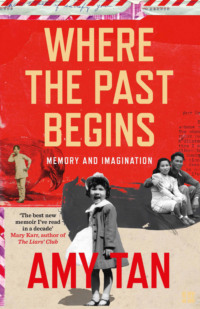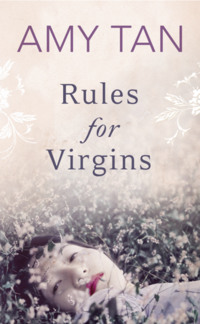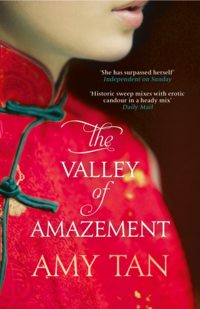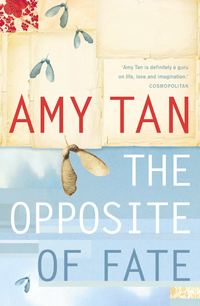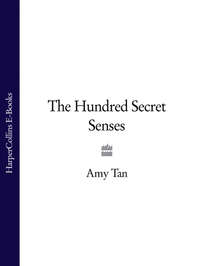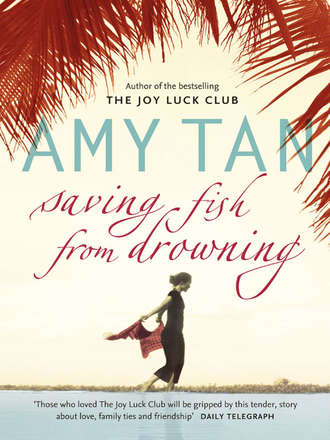
Полная версия
Saving Fish From Drowning

AMY TAN
Saving Fish from Drowning

CONTENTS
COVER
TITLE PAGE
1 A BRIEF HISTORY OF MY SHORTENED LIFE
2 MY PLANS UNDONE
3 SUCH WAS THEIR KARMA
4 HOW HAPPINESS FOUND THEM
5 WE ALL DO WHAT WE MUST
6 SAVING FISH FROM DROWNING
7 THE JACARANDAS
8 IT WAS NOT JUST A CARD TRICK
9 NO TRACE
10 NO NAME PLACE
11 THEY ALL STUCK TOGETHER
12 DARWIN’S FITTEST
13 OF PARTICULAR CONCERN
14 THE INVENTION OF NOODLES
15 A PROMISING LEAD
16 HOW THEY MADE THE NEWS
17 THE APPEARANCE OF MIRACLES
18 THE NATURE OF HAPPY ENDINGS
P.S.
ABOUT THE BOOK
ABOUT THE AUTHOR
READ ON
PRAISE
ABOUT THE AUTHOR
BY THE SAME AUTHOR
COPYRIGHT
ABOUT THE PUBLISHER
1 A BRIEF HISTORY OF MY SHORTENED LIFE
It was not my fault. If only the group had followed my original itinerary without changing it hither, thither, and yon, this debacle would never have happened. But such was not the case, and there you have it, I regret to say.
“Following Buddha’s Footsteps” is what I named the expedition. It was to have begun in the southwestern corner of China, in Yunnan Province, with vistas of the Himalayas and perpetual spring flowers, and then to have continued south on the famed Burma Road. This would allow us to trace the marvelous influence of various religious cultures on Buddhist art over a thousand years and a thousand miles—a fabulous journey into the past. As if that were not enough appeal, I would be both tour leader and personal docent, making the expedition a truly value-added opportunity. But in the wee hours of December 2nd, and just fourteen days before we were to leave on our expedition, a hideous thing happened … I died. There. I’ve finally said it, as unbelievable as it sounds. I can still see the tragic headline: “Socialite Butchered in Cult Slaying.”
The article was quite long: two columns on the left-hand side of the front page, with a color photo of me covered with an antique textile, an exquisite one utterly ruined for future sale.
The report was a terrible thing to read: “The body of Bibi Chen, 63, retail maven, socialite, and board member of the Asian Art Museum, was found yesterday in the display window of her Union Square store, The Immortals, famed for its chinoiserie …” That odious word—“chinoiserie”—so belittling in a precious way. The article continued with a rather nebulous description of the weapon: a small, rakelike object that had severed my throat, and a rope tightened around my neck, suggesting that someone had tried to strangle me after stabbing had failed. The door had been forced open, and bloody footprints of size-twelve men’s shoes led from the platform where I had died, then out the door, and down the street. Next to my body lay jewelry and broken figurines. According to one source, there was a paper with writing from a Satanic cult bragging that it had struck again.
Two days later, there was another story, only shorter and with no photo: “New Clues in Arts Patron’s Death.” A police spokesman explained that they had never called it a cult slaying. The detective had noted “a paper,” meaning a newspaper tabloid, and when asked by reporters what the paper said, he gave the tabloid’s headline: “Satanic Cult Vows to Kill Again.” The spokesman went on to say that more evidence had been found and an arrest had been made. A police dog tracked the trail left by my blood. What is invisible to the human eye, the spokesman said, still contains “scent molecules that highly trained dogs can detect for as long a week or so after the event.” (My death was an event?) The trail took them to an alleyway, where they found bloodstained slacks stuffed in a shopping cart filled with trash. A short distance from there, they found a tent fashioned out of blue tarp and cardboard. They arrested the occupant, a homeless man, who was wearing the shoes that had left the telltale imprints. The suspect had no criminal record but a history of psychiatric problems. Case solved.
Or maybe not. Right after my friends were lost in Burma, the newspaper changed its mind again: “Shopkeeper’s Death Ruled Freak Accident.”
No reason, no purpose, no one to blame, just “freak,” this ugly word next to my name forever. And why was I demoted to “shopkeeper”? The story further noted that DNA analysis of the man’s skin particles and those on both the blood-spattered trousers and the shoes confirmed that the man was no longer a suspect. So who had entered my gallery and left the prints? Wasn’t it an obvious case of crime? Who, exactly, caused this freak accident? Yet there was no mention of a further investigation, shame on them. In the same article, the reporter noted “an odd coincidence,” namely that “Bibi Chen had organized the Burma Road trip, in which eleven people went on a journey to view Buddhist art and disappeared.” You see how they pointed the shaking finger of blame? They certainly implied it, through slippery association with what could not be adequately explained, as if I had created a trip that was doomed from the start. Pure nonsense.
The worst part about all of this is that I don’t remember how I died. In those last moments, what was I doing? Whom did I see wielding the instrument of death? Was it painful? Perhaps it was so awful that I blocked it from my memory. It’s human nature to do that. And am I not still human, even if I’m dead?
The autopsy concluded that I was not strangled but had drowned in my own blood. It was ghastly to hear. So far none of this information has been of any use whatsoever. A little rake in my throat, a rope around my neck—this was an accident? You’d have to be brainless to think so, as more than a few evidently were.
At the postmortem, photos were taken, especially of the awful part of my neck. My body was tucked into a metal drawer for future study. There I lay for several days, and then samples of me were removed—a swab of this, a sliver of that, hair follicles, blood, and gastric juices. Then two more days went by, because the chief medical examiner went on vacation in Maui, and since I was an illustrious person, of particular renown in the art world—and no, not just the retail community, as the San Francisco Chronicle suggested—he wanted to see me personally, as did esteemed people in the professions of crime and forensic medicine. They dropped by on their lunch hour to make ghoulish guesses as to what had happened to cause my premature demise. For days, they slid me in, they slid me out, and said brutish things about the contents of my stomach, the integrity of the vessels in my brain, my personal habits, and past records of my health, some being rather indelicate matters one would rather not hear discussed so openly among strangers eating their sack lunches.
In that refrigerated land, I thought I had fallen into the underworld, truly I did. The most dejected people were there—an angry woman who had dashed across Van Ness Avenue to scare her boyfriend, a young man who jumped off the Golden Gate Bridge and changed his mind halfway down, an alcoholic war vet who had passed out on a nude beach. Tragedies, mortal embarrassments, unhappy endings, all of them. But why was I there?
I was stuck in these thoughts, unable to leave my breathless body, until I realized that my breath was not gone but surrounding me, buoying me upward. It was quite amazing, really—every single breath, the sustenance I took and expelled out of both habit and effort over sixty-three years had accumulated like a savings account. And everyone else’s as well, it seemed, inhalations of hopes, exhalations of disappointment. Anger, love, pleasure, hate—they were all there, the bursts, puffs, sighs, and screams. The air I had breathed, I now knew, was composed not of gases but of the density and perfume of emotions. The body had been merely a filter, a censor. I knew this at once, without question, and I found myself released, free to feel and do whatever I pleased. That was the advantage of being dead: no fear of future consequences. Or so I thought.
WHEN THE FUNERAL finally happened on December 11th, it was nearly ten days after I died, and without preservation I would have been compost. Nonetheless, many came to see and mourn me. A modest guess would be, oh, eight hundred, though I am not strictly counting. To begin, there was my Yorkshire terrier, Poochini, in the front row, prostrate, head over paws, sighing through the numerous eulogies. Beside him was my good friend Harry Bailley, giving him the occasional piece of desiccated liver. Harry had offered to adopt Poochini, and my executor readily agreed, since Harry is, as everyone knows, that famous British dog trainer on television. Perhaps you’ve seen his show—The Fido Files? Number-one ratings, and many, many Emmy Awards. Lucky little Poochini.
And the mayor came—did I mention?—and stayed at least ten minutes, which may not sound long, but he goes to many places in a day and spends far less time at most. The board members and staff of the Asian Art Museum also came to pay respects, nearly all of them, as did the docents I trained, years’ and years’ worth, plus the people who had signed up for the Burma Road trip. There were also my three tenants—the troublesome one, as well—and my darling repeat customers and the daily browsers, plus Roger, my FedEx man; Thieu, my Vietnamese manicurist; Luc, my gay haircolorist; Bobo, my gay Brazilian housekeeper; and most surprising to say, Najib, the Lebanese grocer from my corner market on Russian Hill, who called me “dearie” for twenty-seven years but never gave me a discount, not even when the fruit had gone overripe. By the way, I am not mentioning people in any order of importance. This is simply how it is coming to me.
Now that I think of it, I would estimate that more than eight hundred people were there. The auditorium at the de Young Museum was crowded beyond belief, and hundreds spilled into the halls, where closed-circuit television monitors beamed the unhappy proceedings. It was a Monday morning, when the museum was usually closed, but a number of out-of-towners on Tea Garden Drive saw the funeral as a fine opportunity to sneak into the current exhibit, Silk Road Treasures from the Aurel Stein Expeditions, a testimony, in my opinion, to British Imperial plundering at the height of cupidity. When guards turned the interlopers away from the exhibits, they wandered over to my funeral fête, morbidly lured by copies of various obituaries that lay next to the guest book. Most of the papers gave the same hodgepodge of facts: “Born in Shanghai … Fled China with her family as a young girl in 1949 … An alumna of Mills College and guest lecturer there, in art history … Proprietor of The Immortals … Board member of many organizations …” Then came a long list of worthy causes for which I was described as a devoted and generous donor: this league and that society, for Asian seniors and Chinese orphans, for the poor, the ill, and the disabled, for the abused, the illiterate, the hungry, and the mentally ill. There was an account of my delight in the arts and the substantial amounts I had given to fund artist colonies, the Youth Orchestra with the San Francisco Symphony, and the Asian Art Museum, the location of my funeral, the major recipient of my lagniappes and largesse, before and after death which enthusiastically offered the unusual venue for my funeral, the de Young, in which the Asian museum was housed.
Reading the roster of my achievements, I should have been bursting with pride. Instead, it struck me as nonsensical. I heard a roar of voices coming from every bit of chatter from every dinner, luncheon, and gala I had ever attended. I saw a blur of names in thick, glossy programs, my own displayed in “Archangels,” below those in the fewer-numbered and more favored “Inner Sanctum,” to which that Yang boy, the Stanford dropout, always seemed to belong. Nothing filled me with the satisfaction I believed I would have at the end of my life. I could not say to myself: “That is where I was most special, where I was most important, and that is enough for a lifetime.” I felt like a rich vagabond who had passed through the world, paving my way with gold fairy dust, then realizing too late that the path disintegrated as soon as I passed over it.
As to whom I had left behind, the obituary said, “There are no survivors,” which is what is said of airplane crashes. And it was sadly true, all my family was gone—my father, of a heart attack; one brother, of alcoholic cirrhosis, although I was not supposed to mention that; the other brother a victim of a road-rage accident; and my mother, who passed from life before I could know her. I don’t count my stepmother, Sweet Ma, who is still alive, but the less said about her the better.
The choice of an open-casket ceremony was my fault, the result of an unfortunate aside I had made to a group of friends at a tea-tasting party I had hosted at my gallery the previous July. You see, earlier that week I had received a ship’s container of fantastic items I found in the countryside of Hubei Province. Among them was a two-hundred-year-old lacquered coffin of paulownia wood made by a eunuch singer who had performed in palace theatricals. In death, most eunuchs, except those in the upper echelons of service, were given only the most perfunctory of burials, without ceremony, since their mutilated bodies were not fit to appear before spirit tablets in the temples. In yesteryears, people rich and poor prepared for the netherworld by making their coffins long before they ceased to hear the cock crowing the new day, and the fact that this eunuch was allowed to make such a grand coffin suggested that he was someone’s pet—the prettier boys often were. Alas, this adored eunuch drowned while fishing along the Yangtze, and his body went sailing without a boat, swept away to oblivion. The eunuch’s parents, in Longgang Township, to whom his possessions had been sent, faithfully kept the coffin in a shed, in hopes that their son’s wayward corpse would one day return. The subsequent generations of this family grew impoverished by a combination of drought, extortion, and too many gifts to opera singers, all of which led to their losing face and their property. Years went by, and the new landowners would not go near the shed with the coffin, which was reputed to be haunted by a vampire eunuch. Derelict with neglect, the shed was covered with the dirt of winds, the mud of floods, and the dust of time.
In 1997, when a newly rich farmer started construction of a miniature golf course to adjoin his family’s two-story Swiss-style villa, the shed was unearthed. Amazingly, the coffin had only superficial rot and not much cracking from shrinkage; such is the quality of paulownia, which, though lightweight, is more durable than many harder woods. The exterior had more than fifty coats of black lacquer, as did its short four-legged stand. Beneath the grime, one could see that the lacquer bore whimsically painted carvings of sprites and gods and mythical beasts, as well as other magical motifs, and these were continued on the interior lid of the coffin as well. My favorite detail was a playful Tibetan spaniel on the portion of the lid that would have been opposite the corpse’s face. Having been protected from sunlight, the interior art on the lid was still exquisitely colored against the black lacquer. Neat bundles of paper lined the bottom, and I later determined them to be a short history of the intended tenant of the coffin and the same man’s unpublished poems, tributes to nature, beauty, and—most intriguing—romantic love for a lady from her youth through premature death. Well, I presume it was a lady, though one never knows with some Chinese names, does one? The coffin contained two other objects: a smaller lacquer urn with the name of the eunuch’s dog, the Tibetan spaniel, and a small ivory-rimmed box in which three calcified peas rattled about, said to be the eunuch’s manhood and its two accompaniments.
I could immediately see the coffin was both a millstone and a treasure. I had a few clients—people in the film industry—who might have liked this sort of odd decorative piece, particularly if it still held the petrified peas. But the proportions were awkward. The top extended beyond the length of the coffin like the duck-billed prow of a ship. And it was monstrously heavy.
I asked the farmer to name his price, and he spit out a number that was a tenth of what I was mentally willing to pay. “Ridiculous,” I said, and started to leave. “Hey, hey, hey!” he shouted, and I turned back and uttered a sum that was one-third his initial offer. He doubled that, and I retorted that if he was so enamored of a dead man’s house, he should keep it. I then halved his last price, saying I wanted the infernal box only to store some surplus items I had bought, after which I would chop up the coffin for firewood. “It has lots of room for storage,” the farmer boasted, and upped the ante a wee bit. I heaved the biggest sigh I could muster, then countered that he should make arrangements for his men to deliver it to Wuhan harbor for shipment with the rest of my brilliant bargains. Done! Voilà tout!
Back in San Francisco, once the coffin arrived, I put it in the back room of my shop and did indeed use it to store antique textiles woven by Hmong, Karen, and Lawa hill tribes. Later in the week, I had guests over for a tea-tasting class. We were sampling different pu-erh tuo cha—which is, by the way, the only tea that improves over time; anything else, after six months, you may as well use for kitty-cat litter. With the fifth tasting round, we had come to the gold standard of aged teas, a twenty-year-old vintage of the aptly named “camel breath” variety, which is especially pungent but excellent for lowering cholesterol and extending the life span. “But should I die sooner than later,” I jokingly said, “then this”—and I patted the enormous funerary box—“this magnificent vessel to the afterworld, the Cadillac of coffins, is what I wish to be buried in, and with the top raised at my funeral so that all can admire the interior artistry as well.…”
After I died, more than a few from that tea-tasting soiree recalled my quirky remark. What I said as a witticism was described as “prescient,” tantamount to a “last wish that must be honored,” et cetera, ad nauseam. And so I was made to lie in that shipwrecked coffin, not, fortunately, with the shriveled parts of the eunuch. The ivory-rimmed box with the ghoulish relics disappeared, as did the container with the bones of the eunuch’s beloved Tibetan spaniel—although why anyone would want to steal those sad contents as souvenirs is beyond my imagination.
The museum staff in charge of conservation and restoration did a minor bit of spit and polish, though no repair of chips or cracks. Such is their attitude about maintaining authenticity. A Chinese preservationist would have made it look as good as new, and painted it a nice, bright lacquer red and shiny gold. Because the coffin was rather deep, the bottom was filled with styrofoam in the shape of edamame pods, and over that went a layer of velvet—beige polyester, it was most dreadful. That was how I came to be exhibited in the museum auditorium, lying in a large black-lacquered coffin carved with celestial animals and the name of its intended tenant, who no doubt would seek me out with an eviction notice shaking in his hand.
Had I seriously been making arrangements for a premature death, I would have asked to be cremated like the Buddhist high monks, poof, gone, without attachment to the body. As for a suitable receptacle for my remains, no single urn would have sufficed. I would have chosen nine boxes of different and delicate proportions, all from The Immortals, say, a meander-patterned box from the Southern Song dynasty, a round tao yuanming for collecting chrysanthemum flowers, and—my absolute favorite, which I had overpriced on purpose—a simple Ming brush box made of black-lacquered leather. I used to open it, inhale, and feel the poetry streaming over my face.
The nine well-chosen boxes would have been arranged on a table during the reading of my will, three rows across, three down, like the three tosses of I Ching coins—both random and meaningful. Nine friends, equally chosen with thought from the best of society, would each have been asked to select a box with a portion of my ashes. Per my request, they were each to take me along on a trip to a lovely place—no sedentary fireplace mantels or Steinway piano tops for me—where they might scatter my ashes but keep the box as a memento. The boxes, being museum quality, would have increased in worth over the years, and made people remember me “with growing appreciation.” Ah-ha, they would laugh upon reading that part. Thus, my ashes would have taken a more lighthearted and peripatetic course, and I could have avoided that abhorrent spectacle of an open coffin. But there we all were, me included, waiting our turn to view the macabre.
One by one, these friends, acquaintances, and strangers from the different times of my shortened life stood by the casket to say farewell, adieu, zai jen. Many people, I could tell, were curious to see what the morticians had done to cover up the mortal wound. “Oh my God!” I heard them whisper noisily to one another. To be honest, I, too, was shocked to see how outlandishly they had prepared me for my debut with death. A shiny silver scarf was wrapped into a puffy bow around my lacerated neck. I looked like a turkey with aluminum foil, about to be put in the oven. Even worse, Bennie Trueba y Cela, the docent who grieved for me the most—that is to say, with the greatest display of wracking sobs—had given the mortuary a photo taken during an expedition that a group of us had made to Bhutan three years before. In that picture I looked strong and happy, but my hair was awful—no hot water to wash it for three days. It hung in long greasy strands, the crown was plastered down, and there was a big groove around my forehead where a sun hat had been glued to my scalp with heat and sweat. Himalayas, ha—who knew it would be so hot there, trekking during the daytime? Who knew that Bennie would later give this same photo to a mortuary girl to show her what I looked like “in the best of times.” And that silly girl would give me this same mashed-down Himalayan hairdo. She also colored my skin as dark as a Brokpa maiden’s, so that now people would remember my face all wrong, like a mango past its prime.
Not that I expected everyone to say, “Oh, I remember Bibi, she was beautiful.” I was not. I had a keen eye for beautiful things since girlhood, and I knew my faults. My body was as small and short-legged as a wild Mongolian pony’s, my hands and feet as thick as unread books. My nose was too long, my cheeks too sharp. Everything was just a little too much. That was the legacy of my mother’s side of the family, insufficient excess, too much that was never enough.
Yet I was not dissatisfied with my looks—well, when I was younger, yes, multiply so. But by the time I became a young woman, I knew it was better to be unforgettable than bland. I learned to transform my faults into effect. I darkened my already thick eyebrows, put big-stoned rings on my knobby fingers. I dyed my muddy hair in long streaks of bright gold, red, and lacquer black and wove them into a massive plait that striped the entire length of my back. I adorned myself with layers of unlikely colors, clashing tones married by texture or design or flow. I wore large pendants and medallions, clown-green gaspeite where people expected cool imperial jade. My shoes were my own design, made by a leather worker in Santa Fe. “You see how the toes are curled in the Persian slipper tradition?” I remarked to those who stared too long. “Why do you suppose the Persians started doing that?”




